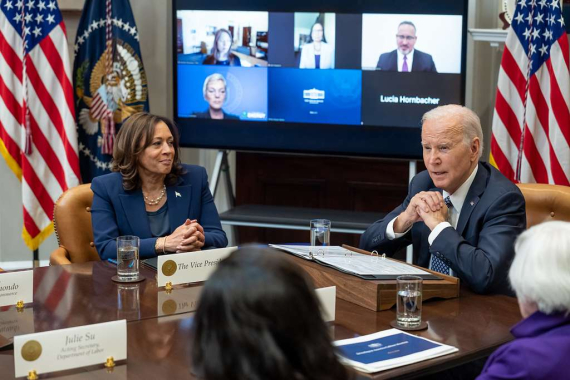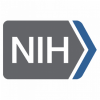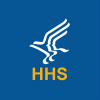
Ahead of World AIDS Day, we remember those who have died from AIDS-related illnesses—honoring their courage and contributions as essential to the progress made thus far. We also stand in solidarity with the more than 39 million people with HIV around the world. Four years ago, the Biden-Harris Administration renewed and strengthened the government’s bipartisan commitment to ending the HIV epidemic. Since then, significant progress has been made through a whole-of-society approach, unprecedented investments, and a steadfast commitment to leading with science, advancing equity, and addressing HIV stigma and discrimination.
Domestically, the implementation of the updated National HIV/AIDS Strategy (NHAS) has not only focused on reducing new HIV infections and improving health outcomes for people with HIV but also expanded efforts to address social determinants of health, reform outdated HIV criminalization laws, and strengthen partnerships with communities and organizations nationwide.
Globally, under the Biden-Harris Administration, the President’s Emergency Plan for AIDS Relief (PEPFAR) released a five-year strategy with five strategic pillars and three enablers designed to end global HIV/AIDS as a public health threat by 2030.
PEPFAR—the largest commitment by any nation to address a single disease in history—has saved more than 25 million lives and enabled more than 7.8 million babies to be born HIV-free across 55 countries since its inception in 2003.
These actions collectively contribute to bending the trajectory of the epidemic toward its eventual end. The latest HIV incidence estimates are continuing to move in the right direction overall, although disparities continue in the U.S.
- In 2022, HIV incidence among people ages 13 and older decreased 12% compared with 2018 in the U.S., driven by a 30% decrease among young people aged 13-24 years.
- In 2022, new HIV infections among gay, bisexual, and other men who have sex with men (MSM) were approximately 16% lower for Black men and 20% lower for White men compared to 2018. There was no decrease in new HIV infections among Hispanic/Latino men, who accounted for 39% of estimated new HIV infections among gay, bisexual, and other MSM in 2022.
- Data also show significant declines geographically in the U.S., with estimated new HIV infections decreasing 16% in the South in 2022 compared with 2018.
- Data show that the rate of HIV-related deaths declined 25%, highlighting the effectiveness of early diagnosis and linking people to care and treatment.
- As of 2022, 36% of people who could benefit from pre-exposure prophylaxis (PrEP) were prescribed this medication, up for 25% in 2020.
Over the past year the Administration acted to:
Expand Equitable Treatment and Prevention of HIV in the U.S.
- Increase Access to HIV Prevention. The U.S. government is committed to expanding access to HIV prevention medications, including long-acting injectable PrEP. The White House continues to work with federal agencies, policymakers, and Congress to expand access to PrEP for uninsured and underinsured individuals, including the proposed 10-year $9.8 billion National PrEP Program. The Centers for Disease Control and Prevention (CDC) launched a new PrEP pilot program in five jurisdictions to accelerate PrEP uptake and improve patient access and utilization. The Centers for Medicare and Medicaid Services (CMS) announced a National Coverage Determination for Medicare Part B coverage of PrEP. This ensures that all Medicare recipients can receive PrEP medication and additional critical services like counseling sessions, HIV testing, and vaccination at no cost. Additionally, the Departments of Health and Human Services, Labor, and the Treasury released FAQs to clarify that long-acting injectable PrEP, as well as related baseline and monitoring services, must be covered without cost sharing.
- Implementing the Ending the HIV Epidemic in the U.S. (EHE) initiative. The U.S. Department of Health and Human Services (HHS) launched the EHE initiative in 2019 to advance innovative, community-driven solutions that leverage science in HIV prevention, diagnosis, treatment, and response in regions with the greatest need. In jurisdictions receiving EHE funding, HIV incidence decreased 21% among those ages 13 and older in 2022 compared with the 2017 EHE baseline year. Between 2021-2023, more than 61,000 people were prescribed PrEP in the CDC EHE-funded programs. The Health Resources and Services Administration (HRSA)-supported health centers provided PrEP services to 183,000 patients with EHE funding in 2021-2023. The Ryan White HIV/AIDS Program supported over 22,000 clients new to care and re-engaged 19,000 clients through EHE, with 79.2% of those new to treatment achieving viral suppression in 2022. With EHE funding, 406 community health centers conducted a cumulative 7.2 million HIV tests, substantially increasing the proportion of their patients aware of their HIV status. Indian Health Service EHE-supported sites performed over 20,000 HIV tests, and the CDC distributed over 600,000 free HIV self-tests. Between 2017 and 2022, the initiative prevented 9,500 new HIV infections in the EHE jurisdictions, saving over $5.1 billion in lifetime HIV medical costs – a figure projected to grow with continued efforts.
Strengthen Global Efforts for HIV Prevention and Treatment
- Leading the Global Fight to End HIV/AIDS as a Public Health Threat by 2030. Through PEPFAR and the Global Fund to Fight AIDS, Tuberculosis (TB), and Malaria (Global Fund), the American people have supported the HIV response in more than 100 countries, investing more than $26 billion over the past four years.
- Providing Greater Access to HIV Prevention. UNAIDS data show there were 52% fewer new HIV infections in 2023 than in 2010 across PEPFAR-supported countries, compared with a 39% reduction globally, demonstrating the impact of PEPFAR support to HIV prevention interventions. PEPFAR supported HIV testing for 83.8 million people, an increase of 12 million compared to last year. PEPFAR also supported 35.1 million voluntary medical male circumcisions for HIV prevention since 2007, including 2.7 million in FY 2024. PEPFAR is delivering on the growing demand across partner countries for highly effective PrEP for HIV prevention. In the last four years, new annual PrEP initiations supported by PEPFAR have increased by more than 500%, reaching 2.5 million people protected from HIV infection in FY 2024. PEPFAR is providing long-acting, injectable PrEP in five countries and is actively working on expansion plans for innovations in long–acting, injectable PrEP that can contribute toward ending HIV/AIDS as a public health threat.
- Expanding Access to HIV Treatment. Over the last four years, PEPFAR added more than 2.1 million people with HIV on life-saving antiretroviral treatment. As of July 2024, PEPFAR is currently ensuring HIV treatment for more than 20.6 million people, including 566,000 children, and more than 14.6 million people are now receiving treatment via multi-month dispensing.
- Supporting the Global Fund. The United States is the largest single investor in the Global Fund, a critical partner to achieving our goal of ending HIV/AIDS, TB, and malaria as public health threats by 2030. Over the last two decades, investments in the Global Fund have cut the combined death rate from HIV/AIDS, TB and malaria by 61% and have helped save 65 million lives.
Ensure Accessible Healthcare and Support Services
PEPFAR Initiatives to Support Equitable HIV Care. PEPFAR launched several major initiatives aimed at addressing health equity for vulnerable populations globally – including adolescent girls and young women, children and key populations. In FY24, PEPFAR also provided support to 6.6 million orphans and vulnerable children living with or affected by HIV/AIDS and their caregivers. Some PEPFAR initiatives include:
- The $40 million Safe Births, Healthy Babies initiative to accelerate progress to eliminate mother-to-child HIV transmission in three high burden countries.
- The $8 million Nursing Leadership Initiative to equip nurses in Botswana, Côte d’Ivoire, Eswatini, Malawi, Nigeria, South Africa, and Zambia with the skills and capacities they need to deliver high-quality HIV services across seven PEPFAR-supported countries.
- The Determined, Resilient, Empowered, AIDS-Free, Mentored and Safe (DREAMS) program reached 2.3 million adolescent girls and young women across 15 countries with comprehensive HIV prevention services, including nearly 475,000 who started PrEP in the past year.
- The Key Populations Action Plan to address the HIV service equity gaps among key population groups that face disproportionate risks of HIV infection and challenges in accessing services.
- Advancing Cervical Cancer Prevention for Women with HIV. Cervical cancer is an AIDS-defining illness, where women with HIV are up to six times more likely to develop persistent precancerous lesions and progress to cervical cancer, often with more aggressive forms and higher mortality. To address this significant health threat, in 2018, PEPFAR, the George W. Bush Institute and UNAIDS established the Go Further Partnership to eliminate cervical cancer among women living with HIV in Sub-Saharan Africa. Go Further partner countries have made tremendous progress and have performed nearly 10 million cervical cancer screens. As of June 2024, PEPFAR reached more than 6.3 million women HIV with cervical cancer prevention services and treated more than 350,000 precancerous lesions.
- PEPFAR’s Commitment to Health Equity. The first pillar of the PEPFAR Strategy focuses on health equity, including advancing gender equitable programs, engaging youth, ending HIV/AIDS in children, promoting key population leadership, ensuring holistic combination prevention, and dismantling structural barriers.
- Sustaining Quality-of-Life for People Living with HIV in the U.S. The National HIV/AIDS Strategy includes five quality of life indicators – overall health, mental health, food insecurity, stable housing, and employment. In observance of World AIDS Day, the White House Office of National AIDS Policy will be hosting a Quality-of-Life Symposium for people with HIV, researchers, federal partners, and public health experts to explore how the HIV service community can increase its focus on ensuring overall wellness for people with HIV across the lifespan and address social determinants of health.
- Supporting the Aging HIV Community. Agencies across the U.S. government are working to address medical and social support needs of people aging with HIV and long-term HIV survivors. HRSA, CDC, and the National Institutes of Health (NIH) have all increased their efforts to conduct additional research, highlight best practices and provide tailored care and support services.
- Ensuring Equitable Access to Care. The NHAS Federal Implementation Plan prioritizes access to PrEP in vulnerable communities, promotes compliance with civil rights laws (including language access services and disability rights), and assists state and local governments in protecting people with HIV from violence, retaliation, and discrimination. Domestic HIV programs, including the EHE initiative continuously strive to create and enhance healthcare systems that provide high quality, affordable, and culturally appropriate prevention, testing, and care for all individuals, especially the priority and key populations identified in the NHAS.
Increase Awareness and End Stigma and Discrimination
- CDC Updates HIV Testing Guidance to Remove Age Limit. CDC updated its HIV testing guidance, removing the previous upper age limit of 64 for routine HIV screening. Under the new guidance, all patients aged 15 and older are encouraged to get tested for HIV at least once as part of routine healthcare. This change is a significant step toward addressing HIV testing stigma by normalizing HIV screening as a lifelong practice and helps promote earlier diagnosis and treatment across all age groups, ultimately supporting efforts to end the HIV epidemic.
- Reform of HIV Criminalization Laws. For the first time, the proposed Fiscal Year 2025 budget invests in state and local efforts to promote equity and protect civil rights through a new $10 million Department of Justice grant program to support modernization of outdated state criminal statutes with a discriminatory impact on people with HIV. Outdated HIV criminalization laws do not reflect our current understanding of HIV transmission, discourage HIV testing, and exacerbate the challenges faced by people with HIV. The Department of Justice reached a landmark settlement with Shelby County, Tennessee, ending discriminatory enforcement of a law that imposed higher criminal penalties for prostitution for people with HIV.
- Adoption of Science Informed Treatment and Messaging. PEPFAR and domestic HIV programs have adopted HIV interventions such as PrEP along with the complementary, life-affirming message of U=U (undetectable =untransmittable) to dismantle stigma and discrimination for people with HIV. U=U means that a person with an undetectable viral load cannot be transmit HIV to other sexual partners.
- Organ Donation between Patients Living with HIV. An NIH-funded clinical trial confirmed that kidney transplantation is safe between donors and recipients with HIV—a practice currently only permitted in the United States under a research protocol. This research was made possible by the HIV Organ Policy Equity Act (HOPE) implemented in 2015 to legalize transplants between donors and recipients living with HIV. The U.S. Department of Health and Human Services (HHS) announced a final rule that will expand access to kidney and liver transplants for people with HIV by removing clinical research requirements for these transplants.
Prioritize Community-Driven Responses
- Mobilizing Rising HIV Leaders. In July, the White House Office of National AIDS Policy hosted The White House Rising Leaders Summit: Shaping the Future of HIV Today. The Summit convened young emerging leaders in public health from diverse communities. The event generated actionable ideas to advance the vision and goals of the Administration’s National HIV/AIDS Strategy (NHAS), solidifying the Administration’s commitment to nurturing innovative leadership in the fight against HIV. Globally, PEPFAR launched a $20 million Youth Initiative to elevate youth leadership in the HIV response to reduce new HIV infections and increase awareness of HIV status among adolescents and young people.
- Hispanic/Latino Community Engagement. In September, the White House Office of National AIDS Policy hosted a Summit on HIV in Hispanic/Latino Communities called, “¡Adelante!” The Summit occurred at a critical moment when Hispanic/Latino people, representing about 19% of the U.S. population, accounted for nearly 32% of all new HIV diagnoses in 2022, with Hispanic/Latino gay men now representing the highest number of new HIV cases in the country. It brought together federal agencies, cross-sector partners, and individuals with lived experience to amplify diverse voices, generate actionable solutions, and drive collective action. This Summit reinforced the Administration’s commitment to accelerating the nation’s HIV response in Hispanic/Latino communities and ensuring sustained impact through collaboration and equity-focused strategies.
- Making the HIV Response More Sustainable. Over the last four years, PEPFAR increased its partnerships with local organizations by 29%, and in FY24 PEPFAR has directly supported more than 380 local partners to build long-term sustainable capacity in partner countries. PEPFAR is focused on ensuring that the large majority of HIV prevention, care, and treatment programs in 2030 and beyond will be led and delivered by governments or by other domestic entities with community engagement and government accountability. PEPFAR also partnered with UNAIDS to launch the development of Sustainability Roadmaps in all PEPFAR-supported countries.
Advance HIV Research and Innovation
- Temporary HIV Remission for Infants. An NIH-supported clinical trial found that, infants who started antiretroviral therapy soon after birth were later able to pause treatment and remain free of detectable HIV for more than a year. Typically, without treatment HIV replication in infants is rapid and detectable within weeks. These findings suggest very early treatment enables the infant immune system to temporarily promote HIV remission.
- Long-Acting HIV Treatment Reduces Barriers. NIH-funded research found long-acting injectable antiretroviral therapy can better maintain viral suppression in people with HIV who experience barriers to daily pill taking. This research builds on the 2021 FDA approval of long-acting injectable antiretroviral therapy that determined these drugs to be safe and effective—a drug development milestone underpinned by U.S. government supported basic science on HIV’s molecular structure.
- HIV Treatment During Pregnancy. An NIH-sponsored study adds to the evidence-base that oral and long-acting injectable PrEP is safe before and during pregnancy. Multiple other studies have also confirmed the safety of oral, long-acting, and vaginal ring PrEP formulations during pregnancy.
- Bridging the Research to Practice Gap. The use of implementation science is essential to test interventions in community settings and address specific challenges with appropriately tailored approaches. The NIH supported 265 implementation science projects that have paired researchers with community partners to test, evaluate, and adapt HIV-related interventions in the EHE jurisdictions.
- Innovative Models for Leveraging Pharmacies in HIV Services. Several NIH-funded EHE projects aim to identify innovative models to leverage pharmacies for HIV testing, prevention (including HIV PrEP), and care through partnerships between academic institutions and state and local leaders. This work includes advancing workforce training curricula to enable pharmacy students, pharmacists, pharmacies, and pharmacy systems to deliver the spectrum of needed HIV services with ease, equity, and effectiveness.
- Catalyzing Regional Manufacturing in Africa. In 2022, PEPFAR announced bold manufacturing targets to procure 15 million HIV tests produced in Africa by 2025 and work alongside partners to shift two million patients on first-line antiretroviral therapy (ART) to African-produced products by 2030. Since 2023, PEPFAR procured nearly 100,000 HIV tests from Africa-based manufacturers and worked with partners to launch an Expert Review Panel for Diagnostics for African manufacturers of HIV rapid tests in order to accelerate the availability of HIV rapid tests produced across the continent.











